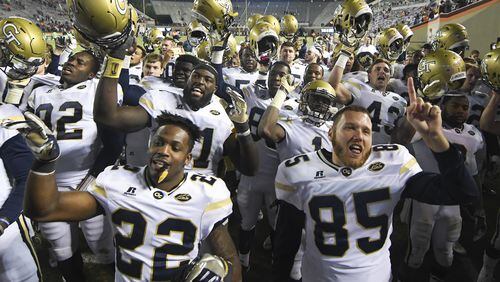Several momentous plays fed into Georgia Tech’s 30-20 win over No. 14 Virginia Tech Saturday. There may have been no more important sequence in the outcome, though, than a six-minute stretch at the end of the first half that pushed the lead from 13-0 to 20-0 going into halftime.
By ESPN’s calculations, the Yellow Jackets entered the segment with a 70 percent win probability. They exited with the probability raised to 90.5 percent.
With 6:27 to play in the half, Georgia Tech took possession of the ball at its 8-yard line, where a three-and-out would return the ball to the Hokies with advantageous field position and plenty of time to cut into the lead. However, quarterback Matthew Jordan outraced the Hokies to the perimeter on first down for 14 yards. On 2nd-and-7 at the Jackets’ 25-yard line, B-back Marcus Marshall ran behind right guard for a nine-yard gain and another first down to advance the ball out of danger. The drive stalled, but not before Georgia Tech had moved out from the 8 to its 40 and eaten up 3 ½ minutes of clock. Ryan Rodwell’s punt was low, but rolled to a stop at the Virginia Tech 6-yard line, finishing a masterful effort of field-position management.
Still, the Hokies had 2:51 to get a half-ending score and gain momentum going into halftime. A week ago against North Carolina, Georgia Tech could not keep the Tar Heels out of the end zone in a similar situation, giving up a two-play, 75-yard drive near the end of the first half that raised the Tar Heels’ lead from 20-17 to 27-17.
However, disaster struck the Hokies on the third play of the drive, when quarterback Jerod Evans couldn’t get a hand on a low shotgun snap that he dove on at the Hokies’ 2-yard line, an 18-yard loss. With the Hokies now facing 3rd-and-26, Georgia Tech now had the chance to get the ball back with enough time for a score of its own. The Hokies punted the ball away with 1:57 left, gaining possession at the Hokies’ 34-yard line.
It was Georgia Tech’s best starting field position since the Vanderbilt game. A-back Clinton Lynch, on one of just two touches all game, took an option pitch from Jordan on 2nd-and-11. With A-back Isiah Willis providing some space with a cut block, Lynch sped 27 yards to the Hokies’ 8-yard line. Marshall and Jordan did the rest, with Jordan punching the ball in from the 3-yard line. Harrison Butker’s PAT raised the advantage to 20-0 with 30 seconds left in the half.
“We needed to hold them to three points and we didn’t,” Hokies defensive coordinator Bud Foster said. “It is what it is. He moved his chess players around better than I did.”
In sum, the Jackets advanced from a 13-0 lead with 6:27 left in the half, backed up inside their 10-yard line against one of the best defenses in the country, to ahead 20-0 six minutes later with determined and savvy running, a big special-teams play, a huge Hokies mistake and efficient red-zone play. In other words, a near opposite of the North Carolina game.
The score stood up even more when center Kenny Cooper and Jordan couldn’t handle the first snap of the third quarter, giving the Hokies a short field and the route to a quick score that cut the lead to 20-7.
“I thought the score right before halftime was big,” coach Paul Johnson said. “To get the touchdown right before we went into half was big for momentum and to get up 20 was huge.”
About the Author







